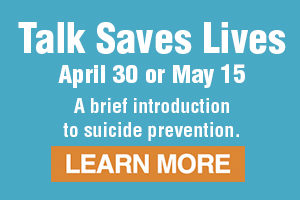 Suicide ideation — thoughts about or a preoccupation with suicide — isn’t just a term to me; I believed my life was worthless at age 17. It took me hours to fall asleep, and I saw no reason to leave the warmth of my bed and attend school. My parents brought me to a counselor, whom I easily fooled into believing I was fine. The next counselor managed to diagnose clinical depression. With therapy and medication, the thoughts of suicide abated, and I began building a mental health toolbox that I continue to use every single day.
Suicide ideation — thoughts about or a preoccupation with suicide — isn’t just a term to me; I believed my life was worthless at age 17. It took me hours to fall asleep, and I saw no reason to leave the warmth of my bed and attend school. My parents brought me to a counselor, whom I easily fooled into believing I was fine. The next counselor managed to diagnose clinical depression. With therapy and medication, the thoughts of suicide abated, and I began building a mental health toolbox that I continue to use every single day.
As a parent now, my quest to be well versed in youth suicide prevention stems from the knowledge that mental health fluctuates for people all the time. Staying alert to distress signals from our children and other teens we know is vital work. Suicide is the second-leading cause of death for people ages 10–24, and there are more than 5,400 suicide attempts by students in grades 7–12 every single day in the United States.
Unfortunately, in Washington state, the suicide rate is 14 percent higher than our country’s national average. A recent survey of our state’s middle and high schools reports that 1 in 10 students “had made a suicide attempt” in the last year while 1 in 5 students “had seriously thought about it.”
Focus on prevention
Parents can learn the warning signs, how to talk about mental health and about the suicide prevention resources within our community. “It is vital to remember: Most suicides are preventable,” writes Jennifer Stuber, Ph.D., cofounder and faculty director at Forefront: Innovations in Suicide Prevention at the University of Washington, in a recent Seattle Times editorial.
While risk factors include issues around relationships, academic pressure, anxiety and family survival issues, being different is also a significant factor, says Sue Eastgard, MSW, cofounder and director of training at Forefront. This includes teens who have physical health issues and teens who identify as lesbian, gay, bisexual or transgender. Some minority groups such as Native Americans are high-risk, but suicide ideation cuts across all populations. Upper-middle-class tweens and teens are under lots of pressure and are at risk, too, says Vicki Wagner, executive director of the Youth Suicide Prevention Program.
“Warning signs are often really subtle: a mood change, a young person who really excelled and now their grades are slipping. Isolation is a real warning sign; someone who is outgoing with family and now doesn’t want to interact. Multiple signs coupled together elevates the risk,” says Wagner. Something seemingly innocuous, like taking a favorite baseball shirt and giving it away, could raise parental alarm bells when paired with other signs, she warns.
Eastgard notes that although teens are notorious for moodiness, erring on the side of caution and investigating is a good idea. Gather information, starting at school and including venues your teenager frequents, from a faith community to a sports environment. If others who interact with your child are seeing worrisome behavior, too, Eastgard recommends seeking counseling for your child.
Warning signs
Forefront lists the following warning signs of suicide on its website. If you observe any of the following signs, call Lifeline at 800-273-TALK (8255).
Your child:
- Talks about wanting to die or kill themselves
- Searches online for ways to kill themselves or buy a gun
- Talks about feeling trapped, in unbearable pain or about being a burden to others
- Begins using alcohol or drugs
- Acts anxious or agitated; behaves recklessly
- Sleeps too little or too much
- Withdraws or isolates themselves
- Shows rage or seeks revenge
- Displays extreme mood swings
For part 2 of this article, please click here.
By Nancy Schatz Alton, courtesy of ParentMap.



